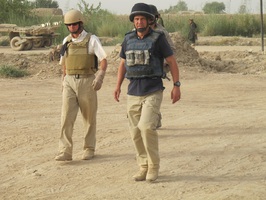Strangers in the House
Not so long ago the arrival of a civilian in a Military HQ was greeted with scenes reminiscent of when the aliens come off the UFO ramp at the end of Close Encounters. Incredulity rather sums it up. Things have improved considerably since then but there is still a long way to go. The following basic guidance might be considered by the staff:
Use or lose – The civilian is invariably an enthusiastic volunteer who will wish to make a contribution. If they are not used they will not come again and you can be sure they will tell their colleagues.
Why are you here? – Too often terms of reference are vague or ill defined. Having invited them you must be clear why you want them. It sounds almost too simple to be true but it is a perennial issue.
Lines of Accountability – Be clear where the civilian lines of accountability run. Invariably they are the supported effort – they are not there as some form of supporting capability owned by the HQ
Early engagement – The HQ must find out what the civilian supported effort is aiming to deliver at the earliest opportunity. Only then can the security agenda be properly applied.
2nd and 3rd Order Consequences
2nd and 3d order consequences are very hard to predict with any great certainty. But as part of any risk assessment it ought to be done. The following is true and hopefully highlights the need for caution or at the very least the fact that good intentions are not always enough.
A new school had been built and for once there seemed to be enough teachers and the wherewithal to actually pay them. The community appeared onside and claims of a lack of security were for once muted. Success all round and so the local military unit decided to add to the general bonhomie by giving each child a kite.
The first challenge was to identify how many kites would be needed. School attendance was optional and it was hard to put a number on how many kids (not girls though) actually turned up. Around 3-500 seemed to be the general consensus but just to be on the safe side 1000 were ordered. Getting a thousand kites made locally was not easy - the end result meant two inevitable consequences. They were incredibly expensive and fantastically shoddy. Local entrepreneurs made a fortune. No philanthropy here.
It was also decided that these would be presented as a gift from the Government. Nobody was fooled but it was in keeping with th mood of the times. Come the day 1000 kites and a few footballs were loaded in to the back of a number of security force pick ups and driven to the school where the assembled staff and pupils were excitedly waiting. Also waiting were the local police who had been asked to make sure that the environment was secure. Apart from them, it was.
The picks up arrived and a few desultory speeches were made by the dignataries. Things then started to go wrong on a number of fronts. The first mistake was for the senior military officer to throw a football into the crowd. Mayhem erupted as pupils, staff and police fought for possession. Concurrently the kites were handed out from the backs of vehicles in to the hands of boys and adults who were determined not to miss out. The cheaply made toys disintegrated as they reached the now hysterical mob. The older boys beat the little boys with sticks, the teachers fought fist fights with the police who were trying to load the gifts onto their trucks. The soldiers uneasily shifted their weapons into their shoulders.
Eventually some form of order was resumed and the kids were ushered and forced back into the school. The ground was littered with debris from the smashed kites. A few valiant attempts to fly the surviving models saw liitle success. A mud and dust covered pile of coloured paper lying on the ground makes a poignant picture.
I asked the Ministry of Interior Colonel for his view on what had happened. To paraphrase, he said 'People here are so poor they will take whatever you give them and work out what to do with it later. There is no room for sentiment'
To add insult to injury there were later reports that the villagers were using any surviving kites as a warning syystem to the local fighters that foreign troops were in the vicinity.
Bet you hadn't thought of that?
Key Leader Engagement (KLE)
Who owns the influence agenda? If you are not sure then you can be certain the people you are trying to influence will quickly work it out. I recall sitting in the foyer of a newly formed Afghan Ministry watching a new western Ambassador arrive in an armoured 4x4 every 15 minutes. All were no doubt firmly of the belief that they held the influence key but clearly it was they who were being influenced.
Any engagement should be assessed in terms of its contribution to the delivery of a line of operation. If security is your Mission why are you digging a well or building a bridge as a result of that friendly meeting with the local warlord? Is there not enough else to do? If it was so critical why have the locals not done it themselves over the past several hundred years? And why are the local NGO's looking on so resentfully?
KLE is critical but delivery must be within the context of a carefully considered unified structure. Ego has to be put to one side and ownership clearly defined. Once establsihed the nominated leaders of each line of engagement should be left to get on with things and not find themselves in a competition for attention. Consistency is in everyone's interest.


